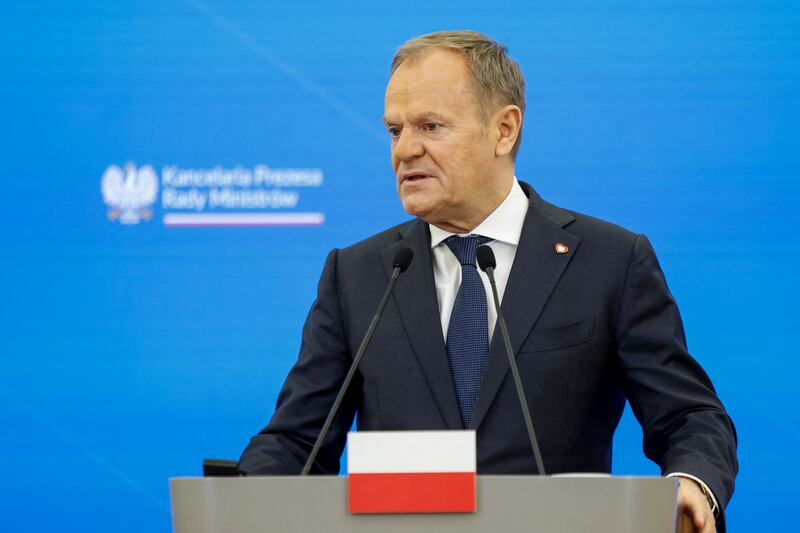Shortly after the first bombs were dropped on Kyiv and the Russian tanks rolled across Ukraine’s border, Sonya Koshkina received a life-changing phone call.
She was on “the list”, the Ukrainian authorities at the end of the line told her.
“They explained to me that I have only two possibilities. I switch off my telephone and give it to them — or I need to leave,” she told The Irish Times.
“The list” began with the annexation of Crimea in 2014. “It’s a blacklist of Ukrainian journalists, activists, politicians — we are ‘enemies of Russia’,” Koshkina explains. “They have addresses, telephones — whole information.”
‘Utterly fearless’: tributes paid to ‘freedom fighter’ Robert Deegan, Irish soldier killed in Ukraine
Former restaurant housing almost 150 Ukrainians to be shut over Christmas due to fire safety concerns
EU needs to be less ‘polite’ in resisting Russian attempts to sway elections
Polish PM Donald Tusk emerges to take leading role on Ukraine
In the early hours of what she now refers to as the “Great Invasion”, Russian special forces were tasked with finding and capturing prominent Ukrainian people. Koshkina (37) was a target, as a prominent journalist and editor-in-chief of the news organisation Lb.ua. “Their goal was to make panic,” she says.
She made the difficult decision to leave. “It was very heartbreaking,” she says. “Kyiv is my native city. My grandfather, my grandmother, everybody is in the central cemetery.”

A big motive for this decision is sitting nearby, engrossed in watching cartoons, at this cafe run by Ukrainian refugees in the Czech capital Prague.
“She was only two years and eight months, and she doesn’t understand what is alarms, why we need to go to the shelter,” Koshkina says of her daughter. “It’s the main reason why I’m here.”
The two fled first to Lviv, and then on across the border, in a 20-hour car journey shared with a family from Kramatorsk. Friends with a daughter of a similar age suggested they join them in their village in the Czech Republic.
She continues her journalism remotely, and quickly found an additional role in radio broadcasting to the 400,000 other Ukrainians who have registered as refugees in the country.
But not everyone made the same choice.
Maksym Levin, a celebrated Ukrainian photographer, had worked for Lb.ua for many years, as well as for Reuters and international media as a stringer.
Koshkina and Levin went through a lot together. It was Koshkina who worked to help the photographer out of the Battle of Ilovaisk in 2014, when Russian troops encircled Ukrainian forces near the city of Donetsk.
“Russians organised a green corridor, but after 10 minutes, they started to bomb them,” Koshkina recalls. With little information on the position of Russian and Ukrainian troops, Levin made the rash decision to pick a direction and drive straight.
“He had a very good car, an Infiniti, and this car really was the price of his life,” Koshkina remembers.
Over the phone, Koshkina worked to guide Levin and his colleagues out, at one point directly telephoning the Ukrainian minister of defence to demand help.
Russian and separatist forces “shot the car four times,” Koshkina recalls. “How they lived I don’t understand, really. When I saw this car, it was without windows, with only three wheels... how?”
On March 13th this year, Levin failed to return from a reporting trip.

For three weeks, he remained missing. In time, Ukrainian forces retook control of the area, pushing Russian troops out of the forest and adjoining village of Moshchun, in the Kyiv region.
Among the trees, soldiers discovered the scene of an apparent assassination: Levin’s car, with 14 bullet impacts. Koshkina was sent photographs of two bodies to identify. Levin had been shot several times.
The photographer left behind four children. “Three days ago, he would have been 41,” Koshkina says flatly.
For others, the search continues.
“In Mariupol, 14 journalists disappeared,” Koshkina says. She mentions “my colleague Dmytro Khilyuk”, a news agency journalist missing since March. “We are not sure if he is alive, we don’t know.”
Alongside the armed conflict, there is a struggle for control of the information space. In occupied areas, Russian forces have worked to shut down Ukrainian broadcasters and replace them with pro-Moscow channels, reusing tactics deployed in Crimea since it was annexed in 2014.
For a long time, Koshkina’s news organisation has relied on the information passed along by residents to report on the breakaway regions in Ukraine’s east. “There is no free media in Donetsk or Luhansk,” she says.
In all, 33 journalists have been killed since the invasion of Ukraine up to June 24th, according to a tally kept by Ukrainian NGO the Institute of Mass Information. Some had joined the armed forces; some died as ordinary civilians, bombed in their homes.
“Eight were killed during the performance of professional duties, like my Maksym.”



